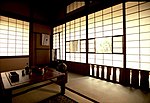Sagami River Bridge ruins
Archaeological sites in JapanChigasaki, KanagawaHistoric Sites of JapanHistory of Kanagawa PrefectureKamakura period ... and 1 more
Natural monuments of Japan

The Former Sagami River Bridge (旧相模川橋脚, kyū-Sagami-gawa kyōkyaku) is the ruins of a Kamakura period bridge over the former course of the Sagami River, located in what is now the city of Chigasaki, Kanagawa Prefecture in the southern Kantō region of Japan. The site was designated a National Historic Site of Japan in 1926, with the area under protection expanded in 2007. It was further designated as a Natural Monument in 2013.
Excerpt from the Wikipedia article Sagami River Bridge ruins (License: CC BY-SA 3.0, Authors, Images).Sagami River Bridge ruins
Chigasaki
Geographical coordinates (GPS) Address Nearby Places Show on map
Geographical coordinates (GPS)
| Latitude | Longitude |
|---|---|
| N 35.331944444444 ° | E 139.38444444444 ° |
Address
252-0065 Chigasaki
Japan
Open on Google Maps










